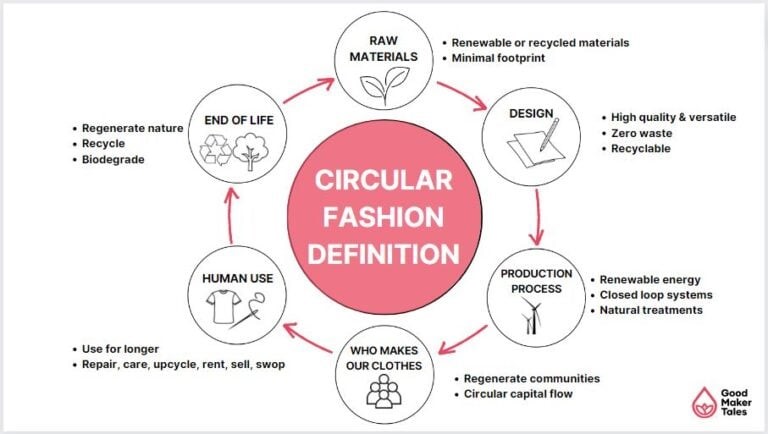Introduction
Circular fashion represents a transformative approach to the fashion industry, aiming to create a closed-loop system where garments and materials are continually reused, reducing waste and minimizing environmental impact. This model challenges the traditional linear fashion system, which typically follows a “take-make-dispose” pattern, leading to significant resource depletion and pollution.
Understanding Circular Fashion
At its core, circular fashion seeks to design, produce, and consume clothing in a way that extends the lifecycle of garments, reduces waste, and promotes sustainability. This involves:
- Designing for Longevity: Creating durable and timeless pieces that withstand trends and wear, encouraging consumers to keep and cherish their garments longer.
- Using Sustainable Materials: Employing eco-friendly, renewable, or recycled materials in garment production to minimize environmental impact.
- Facilitating Repair and Upcycling: Encouraging the repair, alteration, and upcycling of clothing to extend its life and reduce the need for new resources.
- Implementing Circular Business Models: Adopting practices like rental, resale, and take-back schemes to keep garments in circulation and out of landfills.
The Principles of Circular Fashion
The Ellen MacArthur Foundation outlines three key principles for a circular economy in fashion:
- Designing for Longevity: Creating high-quality garments that last longer and remain in use.
- Using Safe and Renewable Inputs: Sourcing materials that are either renewable or recycled, ensuring they can be safely returned to the environment or reused.
- Keeping Products in Use: Implementing business models that encourage the reuse, repair, and recycling of garments, ensuring they remain valuable throughout their lifecycle.
Benefits of Circular Fashion
Circular fashion offers numerous advantages:
- Environmental Sustainability: By reducing waste and promoting the reuse of materials, circular fashion helps conserve resources and decrease pollution.
- Economic Opportunities: The circular model fosters new business avenues, such as repair services, rental platforms, and resale markets, contributing to economic growth.
- Consumer Engagement: Encourages consumers to make more sustainable choices, fostering a culture of mindful consumption.
Challenges in Implementing Circular Fashion
Despite its benefits, transitioning to a circular fashion system presents challenges:
- Infrastructure Limitations: The current recycling and repair infrastructure may not be equipped to handle the volume of garments requiring processing.
- Consumer Behavior: Shifting consumer habits towards renting, repairing, or buying second-hand can be challenging due to convenience and cultural preferences.
- Industry Resistance: Some brands may be hesitant to adopt circular practices due to perceived costs or complexities in altering established business models.
Global Initiatives and Innovations
Various organizations and companies are leading the way in promoting circular fashion:
- The Ellen MacArthur Foundation: Advocates for a circular economy in fashion, providing resources and frameworks to guide industry transformation.
- Refiberd: A startup that won the CFDA x eBay Circular Fashion Fund, focusing on textile recycling using advanced technologies like hyperspectral imaging and AI to accurately classify garment materials .
- H&M Group: Collaborates with luxury brands to enhance circular clothing initiatives, aiming to make fashion both eco-conscious and human-conscious .
The Future of Circular Fashion
The future of fashion lies in embracing circularity. By redesigning systems, adopting sustainable practices, and fostering collaboration across industries, circular fashion can lead to a more sustainable and equitable fashion ecosystem. This transition requires collective effort from designers, brands, consumers, and policymakers to create a fashion industry that values longevity, sustainability, and ethical practices.
